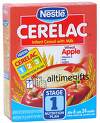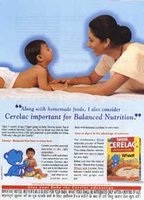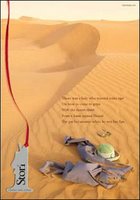Brand : Cerelac
Company: Nestle
Agency: McCann Healthcare
Brand Count 136
Cerelac is the market leader in the Rs 3oo crore Baby Cereal market in India. With a market share of 85%, the brand have a huge equity in the Indian market. The brand right now is facing the worst nightmare of its lifetime .
a market share of 85%, the brand have a huge equity in the Indian market. The brand right now is facing the worst nightmare of its lifetime .
In Kotler's Marketing Management text, he elaborates on the various external environmental factors that affect marketing . In that chapter, he talks about the regulation and laws affecting the marketing of a product. Cerelac is a classic example of Regulations negatively impacting the marketing of a brand.
The infact foods market is a very sensitive market. Since it is concerning infants , the stakeholder's interests are high. In India the market is regulated by an act IMS act of 1992. The act lays down the rules for marketing infant foods and other products in the market. Earlier the law prohibited any advertising and marketing campaigns for baby foods for babies under 4 months of age.Recently the act was amended and restricted any promotion of foods for infants upto the age of 2 years. This amendments was a severe blow for Cerelac whose target market was in fants.
fants.
Company: Nestle
Agency: McCann Healthcare
Brand Count 136
Cerelac is the market leader in the Rs 3oo crore Baby Cereal market in India. With
 a market share of 85%, the brand have a huge equity in the Indian market. The brand right now is facing the worst nightmare of its lifetime .
a market share of 85%, the brand have a huge equity in the Indian market. The brand right now is facing the worst nightmare of its lifetime .In Kotler's Marketing Management text, he elaborates on the various external environmental factors that affect marketing . In that chapter, he talks about the regulation and laws affecting the marketing of a product. Cerelac is a classic example of Regulations negatively impacting the marketing of a brand.
The infact foods market is a very sensitive market. Since it is concerning infants , the stakeholder's interests are high. In India the market is regulated by an act IMS act of 1992. The act lays down the rules for marketing infant foods and other products in the market. Earlier the law prohibited any advertising and marketing campaigns for baby foods for babies under 4 months of age.Recently the act was amended and restricted any promotion of foods for infants upto the age of 2 years. This amendments was a severe blow for Cerelac whose target market was in
 fants.
fants. Along with this regulatory factor , other factors also affected this brand. The major influencers of this product ;the doctors began recommending normal food for infants. Another major influencer WHO began global campaign on promoting breast milk and the government began to demarket milk substitutes.
The marketers (generally speaking) were also responsible for creating such a situation. The brands were promoted using claims not validated and there were also quality and health issues that was ignored. Seeing all the chubby babies on the ads, it is said that mothers started feeding infants with artificial foods that may have caused health problems. ( I have not yet come across any such serious health issues in kids who took these foods).
The new amendment prohibits use of baby models in the packs and restricts any form of promotions including sponsoring doctor conferences, surrogate ads, events etc. For sure this may have a huge impact on the market for such kind of products.
Sensing the threat to the category of Cerelac, Nestle has launched a brand Ceremeal ( a porridge) for kids aged above 2 years.
Now Cerelac sells through word of mouth publicity. The product will sell because there is a need for such nutritional infant foods in the market. Even there is going to be a huge potential for infant milk substitutes because of changing lifestyle and the fact that there is an increase in the number of working mothers.
Cerelac as a brand has not written off its future. In 2003, the brand launched a new formulation Cerelac 123 aimed at different stages in a baby's growth chart.
Since the brand is not advertised, the positioning is not very obvious. The brand is basically positioned as a highly nutritious food for infants.
So here the million dollar question for the marketer is this :
How do you promote such a product where there cannot be any promotion?
Surrogate advertising will be caught by the civil society workers and unnecessary controversy will be created. Events are also ruled out.
As of now the company rely on the shelf promotion for the product. The company has launched lot of flavours and variants in attractive colorful packages that give a banner effect at the shops.
The product is priced at a premium and does not have any sales promotions giving the company value growth.Since the brand is facing little competition, the lack of media promotions may not hurt the company too much.
One thing I have noticed is that the brand has a cute mascot or brand character . It is a blue teddy ( I am not sure whether it is named). If the brand wants to aggressively promote, then Teddy can show the way. Start giving away this small teddy with Cerelac and kids are gonna love it. The marketer can do wonders if they have a cute Mascot /Character.
Cerelac has one, use it.
source: businessline, agencyfaqs, magindia, nestleindia
Disclaimer : This is an analysis of the Cerelac brand in the point of view of a marketer, not a promotion of this brand.








